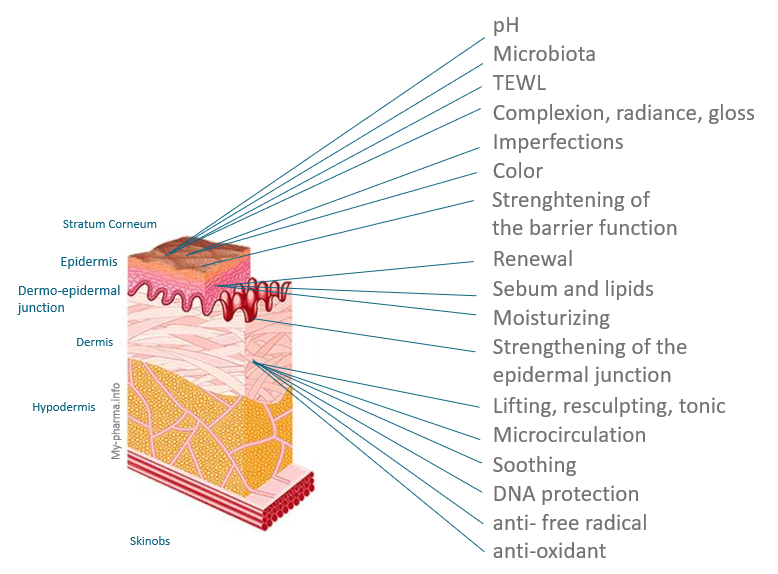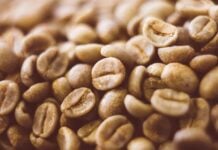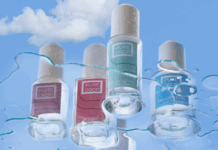Anne Charpentier, founder of Skinobs, a company that publishes technical platforms dedicated to testing in vitro and ex-vivoIn the context of the clinical evaluation of the signs of aging correlated to hormonal changes, and to menopause in particular, this article sheds light on the clinical evaluation of the signs of aging correlated to hormonal changes, and to menopause in particular.
How do we clinically assess the change in skin caused by the hormonal changes associated with menopause?
Intrinsic skin aging correlated to hormonal deficiency, particularly related to menopause, is similar to age-related aging. Its main manifestations are progressive, with great inter-individual variation. The skin changes that appear indicate the skin's hormonal dependence and can lead to a decrease in self-esteem and well-being. Extrinsic aging, due to environmental factors often called exposome - sun, tobacco, alcohol, pollution, diet, sleep, stress - represents about 70 % of aging. It modifies the genetic capital, but it is reversible. SkinObs summarizes the different evaluation options.
We can categorize the signs of skin aging due to menopause as follows:
- Color and pigmentation of the skin: redness, radiance, age spots, homogeneity and radiance of the complexion,
- Skin topography: crow's feet, furrows, roughness,
- Hydration and NMF (Natural Moisturizing Factors): epidermis, dermis
- Skin structure: density, thickness, epidermal junction, barrier function,
- Volume: Facial slackening, oval of the face, bags, eyelids,
- Biomechanical properties: firmness, tone, elasticity, collagen, etc.
Studies on the perception of cutaneous hormonal aging show that the category of skin care for postmenopausal skin is similar to that of care related to aging factors, including intrinsic hormonal changes. In addition to the geographical variations of their regulatory status according to each country, their performance generally announces several effects related to various cellular and biochemical mechanisms (microbiota, keratinocytes, fibroblasts, melanocytes, nerve receptors...)
- Targeted on action mechanisms: Hydration, skin relief, collagen, cell communication, dermal-epidermal junction...
- Localized: wrinkles, oval of the face, neck, hands..,
- Focused on different skin depths: epidermis, dermo-epidermal junction, dermis
In addition to their classic effectiveness on the skin's surface and structure, skin care products dedicated to menopausal skin provide improvements in emotional well-being and sensoriality. The cutaneous signs of aging continue to be studied with great precision, to provide tangible proof of the product's performance. The promise is generally a recovery of tissue elasticity, volume and facial shape. The table below summarizes the various associated claims.

How to objectify "pro-aging" skin care for skin affected by hormonal changes related to menopause?
If we integrate the notion of "well-being" in the proposed treatments, the term "Pro-age" or "plain-age" seems more appropriate than "anti-aging", because it takes into account the condition of the skin in its entirety. Numerous pro-ageing performance analysis solutions are available to cosmetic brands to clinically demonstrate the effects of their products via biometrological and scientific measurements.
The identification of the properties of these "pro-age" products is based on a sensory, sometimes neurosensory and holistic approach. Feelings and impacts on quality of life are measured. Five main categories of tests are available to investigators: consumer tests, sensory or emotional analyses, biometrological studies, and clinical scores.
SkinObs has listed in the table below the devices used to validate the performance of skincare products to combat hormonal changes caused by menopause, via quantitative, semi-quantitative or imaging objectification. The protocol can be multiparametric, depending on the effects to be studied.

We remind you that it is essential to take the time, with the test laboratories, to design each protocol and to define precisely the inclusion criteria, the kinetics of the time measurements, the treatment conditions, and the most suitable instrumental method.
Perspectives on the evolution of evaluation processes
Skin imaging, from the centimeter to the nanometer scale, is increasingly crucial. It allows to measure with great precision the different elements and structures of the skin: water, lipids, dermal-epidermal junction, extracellular matrix, fibers etc.
These various highly technical biometrological measurements lead to a connection between technology and the new digital uses of personalization, from the store to the bathroom. This connection between objectification and the digital way of choosing and buying can bring cosmeticians closer to the reality of marketing. Whether for aging, radiance, biomechanical properties or hydration, the different techniques bring higher resolution, wider measurement area, non-invasive, non-contact and direct methods. Algorithms and statistics will be the key success factors of these new technologies.








